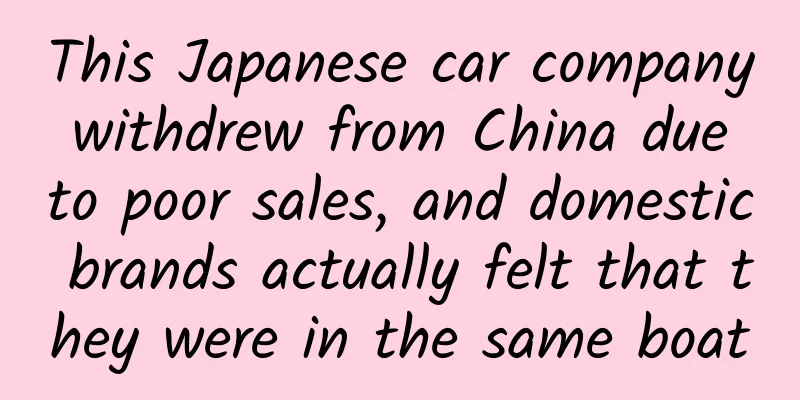This Japanese car company withdrew from China due to poor sales, and domestic brands actually felt that they were in the same boat

|
On June 15, BAIC Changhe announced that the Japanese shareholders of Changhe Suzuki have transferred all Changhe Suzuki shares to Changhe Automobile with government approval. With the release of this news, the news that Suzuki will withdraw from the Chinese market has been reported again, and Changan Suzuki urgently refuted the rumor. Suzuki had no choice but to withdraw from Changhe. In recent years, Changhe Suzuki's new product launches have almost stagnated, and market sales have been dismal. From January to April this year, Changhe Suzuki's sales were only 5,301 vehicles. Changan Suzuki is also in a bad situation. In 2017, Changan Suzuki's annual sales were 86,513 vehicles, a sharp decline of 26% year-on-year, and a loss of 84.82 million yuan. From January to May 2018, Changan Suzuki's cumulative sales were 21,000 vehicles, a year-on-year decline of 47%. Although the Chinese market has suffered setbacks, Suzuki's global performance is still remarkable. In 2017, Suzuki's global sales reached a record 3.22 million units, and the Indian market contributed more than half of the sales. Suzuki's cold reception in the Chinese market is closely related to its own conservatism. Suzuki once flourished in China with its small car strategy. However, with the development of China's economy, automobile consumption has gradually upgraded. The market for mini and small cars, which Suzuki mainly focuses on, has gradually shrunk. Facing market changes, Suzuki did not transform in time. After the rise of new energy vehicles, Suzuki did not follow up. Being eliminated by the Chinese market is also in line with people's expectations. At present, Suzuki is preparing to shift its focus to the Indian market. Fiat is in a similar situation to Suzuki. This is the second time Fiat has entered the Chinese market, but its sales are still poor, and quality issues have triggered a large-scale recall. In early June, its CEO said that he was considering withdrawing Fiat from the Chinese market. Faced with the increasingly competitive Chinese auto market, the era of joint ventures "making money without doing anything" is over. The tragedy of Suzuki and Fiat is just the beginning, and a large-scale industry reshuffle is still to come. The dilemma of joint ventures in second- and third-tier cities Judging from the sales data of China's automobile industry in the past decade, the high growth of my country's automobile development has ended. In 2017, the growth rate of China's passenger car market was only 1.4%. China's automobile market has entered the stock era from the incremental era. At the same time, China's own auto brands have made great progress. From 2015 to 2017, the market share of China's own brand passenger cars has increased for three consecutive years. In 2017, my country's own brand passenger cars sold 10.847 million units, a year-on-year increase of 3%, accounting for 43.9% of the total passenger car sales. Not only is the market share increasing, but Chinese domestic brands are also gradually advancing. The emergence of high-end brands such as Lynk & Co and WEY has further enhanced the competitiveness of domestic brands. The increase in the market share of domestic brands is largely due to their success in the SUV market. Domestic brands have already accounted for more than half of the SUV market, and their prices are also rising. The hot-selling models of Geely Boyue are concentrated between 130,000 and 150,000 yuan, and the Internet models of SAIC Passenger Vehicle's Roewe RX5 are in the price range of 150,000 to 180,000 yuan. In the past two months, the performance of domestic brand passenger cars has been very good. In terms of passenger car wholesale volume in April and May this year, Geely, Great Wall, and SAIC Passenger Cars all ranked in the top ten. Geely also surpassed SAIC-GM-Wuling for the first time and ranked fourth. Geely's growth reflects the progress of its own brands. In 2017, Geely achieved rapid growth, with annual sales reaching 1.24 million units, a year-on-year increase of 63%. The overall level of Geely's products has also been greatly improved. In 2017, the sales volume of models priced between 80,000 and 150,000 yuan accounted for 60%, of which the sales volume of models priced between 100,000 and 150,000 yuan exceeded 21% for the first time. The prices of domestic brands are rising, squeezing the market share of traditional second- and third-tier joint ventures. At the same time, first-tier joint ventures are starting to expand downward due to the relative saturation of competition in their price range. Second- and third-tier joint ventures in the middle are being squeezed from both sides. Second-tier joint venture brands previously occupied the mid-range car market with their good looks and good price/performance ratio, and their brand influence was neither good nor bad. Now, domestic brands with better price/performance ratio and first-tier joint ventures with higher brand premiums have begun to invade, causing the market share of second-tier joint ventures to be continuously eroded. At present, the automobile market in China's first- and second-tier cities is becoming increasingly saturated, and cities below the third tier have become the focus of competition. In these areas, independent brands have been operating for many years and have occupied them in advance. It is difficult for second- and third-tier joint ventures to penetrate downward, while the automobile market in first- and second-tier cities is dominated by mainstream joint ventures. In 2017, the domestic passenger car market share was calculated by brand and country. The market share of Chinese, German, Japanese and American brands increased, while that of Korean and French brands decreased, with Korean brands experiencing the largest decline. Most French and Korean joint venture brands have been squeezed out of the top ten sales rankings by domestic brands. In 2017, the total sales volume of the French joint venture brand Changan DS was less than 6,000 units, and dealers withdrew from the network one after another, resulting in a loss of 1.1 billion yuan. Currently, DS has closed stores in many cities in China. Since 2014, Hyundai's Kia has only achieved a slight increase in 2016, and has been declining in other years. In 2017, sales fell directly to 322,100 vehicles, a decrease of 50.35%. Similar joint ventures include Changan Peugeot Citroen (PSA)'s DS brand, which sold 3,133 vehicles, a year-on-year plunge of 46.31%; Changan Suzuki, which sold 45,700 vehicles, a year-on-year plunge of 20.1%; and Dongfeng Yulon Luxgen, which sold 8,359 vehicles, a year-on-year plunge of 61%. The plight of some second- and third-tier joint ventures foreshadows a new round of changes in the Chinese auto market. The crisis of independent brands Domestic brands are rapidly differentiating themselves from each other. In 2017, the top ten Chinese auto brands accounted for 79.76% of the total sales of domestic brands, while the rest of the domestic brands accounted for only 20.24%. The winner takes all, and this is also true for domestic brands. Among the top 15 domestic brands in terms of sales in 2017, six, including SAIC, Geely, Dongfeng, GAC, Southeast and Hawtai, achieved year-on-year growth, while nine automobile companies, including Changan, Great Wall, BAIC, Chery, Brilliance and JAC, experienced negative growth to varying degrees. Under fierce market competition, although some domestic brands are making continuous progress, many domestic brands are in a worrying situation. For example, Lifan Motors is still "reversely developing" to save development costs; Southeast Motors has only one SUV model that can be shown off; Huatai directly bought the molds of Chery's obsolete products to save costs and turned them into electric vehicles to launch as new cars. It has to be admitted that many domestic brands have weak independent research and development capabilities, are heavily dependent on foreign technology, and their products remain at the low end. Some domestic brands can only follow suit and copy, relying solely on low prices to win the low-end market. Currently, the Chinese automobile market has begun to compete for existing market share, and competition between different brands will become more intense in the future. Starting from July 1 this year, my country's import tariffs on complete vehicles and auto parts will be reduced. Since imported vehicles account for a relatively low proportion of my country's auto market, it will not cause too much fluctuation in the overall market price. However, since domestic brands are mainly low-end models and are currently working hard to improve their brands, the reduction in tariffs will still have a greater impact on the upgrading of domestic brands. On April 17, the National Development and Reform Commission made it clear that it would lift restrictions on foreign equity in joint venture auto companies and gave a specific timetable. After a five-year transition period, all restrictions in the auto industry will be lifted. Five years later, the domestic auto market environment will be similar to the international market, and the situation of independent brands lacking technology and brands will be even more difficult. The chairman of Geely Holding Group has long expressed his hope to speed up the relaxation of restrictions on foreign equity. The relaxation of equity ratio means fairer market competition, and leading companies will have the opportunity to integrate more advantageous resources. For some brands that are more dependent on joint venture partners, such as Brilliance and Changan, this may mean challenges such as reduced voice or even withdrawal of investment by foreign companies. The development trend of electrification, intelligence and networking in the automotive industry provides an opportunity for domestic brands to overtake others. However, a large number of new energy vehicle projects have been launched, and with the integration of the market, only a few will survive. Currently, none of the popular Internet car manufacturing companies can deliver in batches. In 2017, Zhu Huarong, president of Changan Automobile, said that it would be very satisfying if five domestic brands could survive well in the next five years. In the next few years, China's auto industry will face drastic changes. For those automakers that lack technology and brands and cannot adapt to policy and market changes, they will face the fate of being eliminated. For strong companies, although there are constant challenges, there are also many opportunities. As a winner of Toutiao's Qingyun Plan and Baijiahao's Bai+ Plan, the 2019 Baidu Digital Author of the Year, the Baijiahao's Most Popular Author in the Technology Field, the 2019 Sogou Technology and Culture Author, and the 2021 Baijiahao Quarterly Influential Creator, he has won many awards, including the 2013 Sohu Best Industry Media Person, the 2015 China New Media Entrepreneurship Competition Beijing Third Place, the 2015 Guangmang Experience Award, the 2015 China New Media Entrepreneurship Competition Finals Third Place, and the 2018 Baidu Dynamic Annual Powerful Celebrity. |
>>: Should LeEco’s employees pay the price for the negative impact it has on them?
Recommend
Marshall Kilburn II portable speaker: rocking the rock blood with a retro and unruly attitude
Since its birth in 1962, Marshall audio has becom...
Is the franchise fee of Zhumadian Movie Mini Program high? List of franchise fees for Zhumadian Movie Mini Program
How much does it cost to join a movie mini progra...
Geely has better and better cards in its hand. Does Great Wall still need to rely on sharp operations to show off its skills?
In the automotive industry, there is a joke that ...
Is the new iPhone SE your next iPhone?
When everyone thought that the 2018 iPhone 8 seri...
How did the most silent organ in the body turn into a killer?
【Written at the end】 In 2020, more than 410,000 p...
Soap and mosquitoes: the secret weapon to defeat the "return of the south wind"?
Recently, the unique phenomenon of "returnin...
Apple's successes and failures in 2015
[Abstract] In 2015, Apple's smartphone profit...
YouTube video marketing, tips to improve ad conversion rates!
Are you struggling to grow your YouTube channel? ...
New nuclear weapons make 4K gaming a normal practice ASUS ROG STRIX GTX 1080 review
NVIDIA CEO Jensen Huang once announced at the GTX...
Inventory: Top 10 classic cases of AR marketing
The magic of AR is that anyone with a smartphone ...
A number about Harvard graduates
In 2007, 44% of Harvard graduates entered the fin...
Qifenxuetang "Tiaodao" video tutorial
Qifenxuetang "Tiaodao" course introduct...
How do electronic screens quietly "steal" children's vision health?
Source: Ni Xiaojiang & Jing'an CDC...
Shen Hong, professor of advertising at Minzu University of China: Large-screen marketing needs to bring consumers into the consumption scene
On September 22, at the "2017 China OTT Larg...









